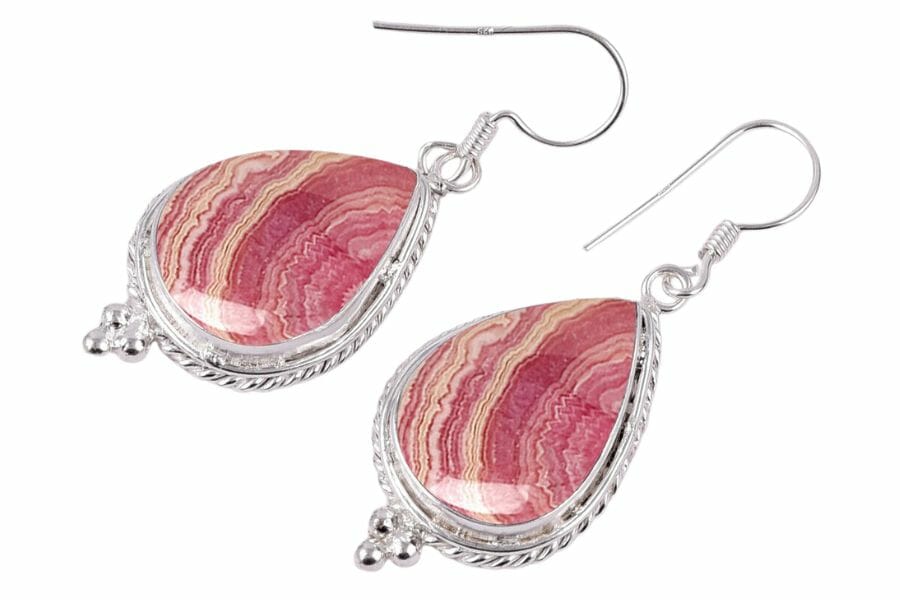A lot of the time, it can be easy to mix up rhodonite and rhodochrosite. They’ve got similar names, they’re both pretty pink, and honestly, it’s no wonder that people can get confused.
That’s where we come in. We’re all about helping you spot the differences (and appreciate the similarities) between these two sparkling stars of the mineral world. By the end, you’ll be able to tell rhodonite vs rhodochrosite with little trouble.
So, get your gear ready. Whether you’re a pro collector, a jewelry lover, or someone who just loves digging in the dirt for hidden gems, you’re going to dig this! Let’s dive in, and get ready to rock and roll with rhodonite and rhodochrosite.
Rhodonite vs Rhodochrosite – The Major Differences
Even though rhodonite and rhodochrosite have a lot in common, they’re also unique in their own ways. So, come with us as we play detective and find out what makes these two minerals stand out from each other.
Appearance – Rhodonite has black and brown veins
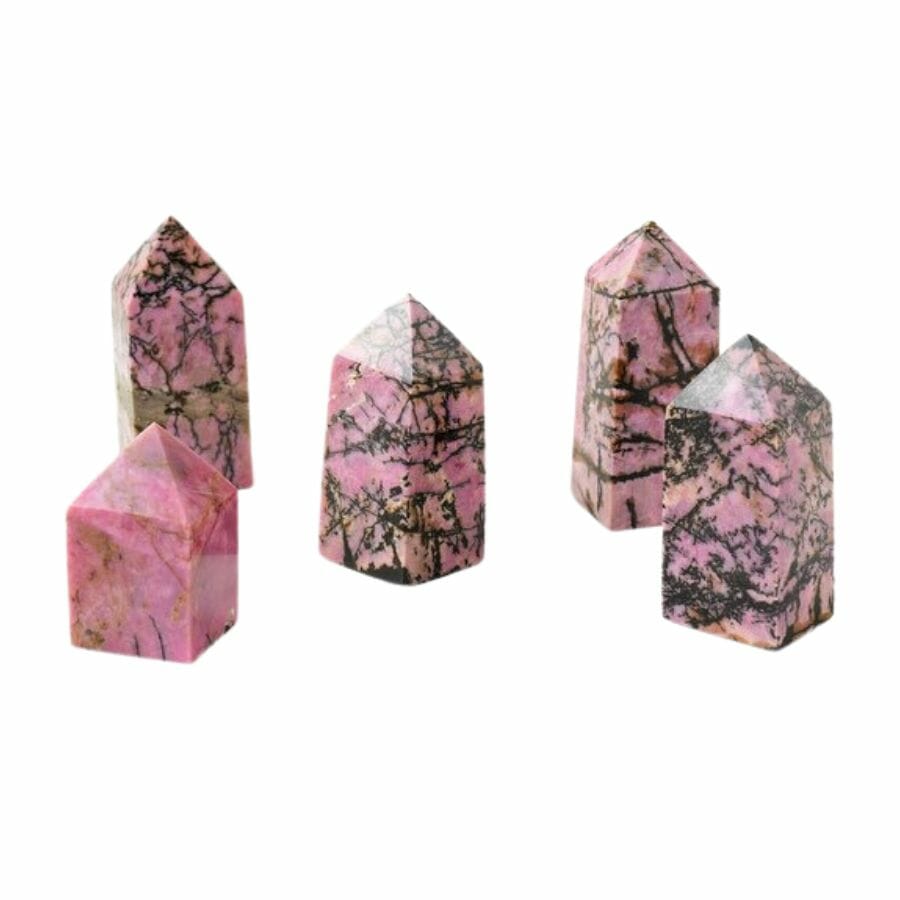
Rhodonite and rhodochrosite may seem like twins when you first look at them, but look again! Each one has its own unique style.
Rhodonite is like the cool, edgy twin, with black or brown streaks running through it. Those are actually veins of manganese oxide, and they create a stark contrast that makes rhodonite stand out.
Now, rhodochrosite, on the other hand, has a whole different vibe. Its claim to fame is its beautiful banded patterns. The effect is kind of like the layers you see in a cake or even the fat and meat in a piece of bacon.
So, while both these gems have their own special quirks, checking out their surface patterns will help you tell which one is which in no time.
Colors – Rhodochrosite is a lighter, more pastel pink color
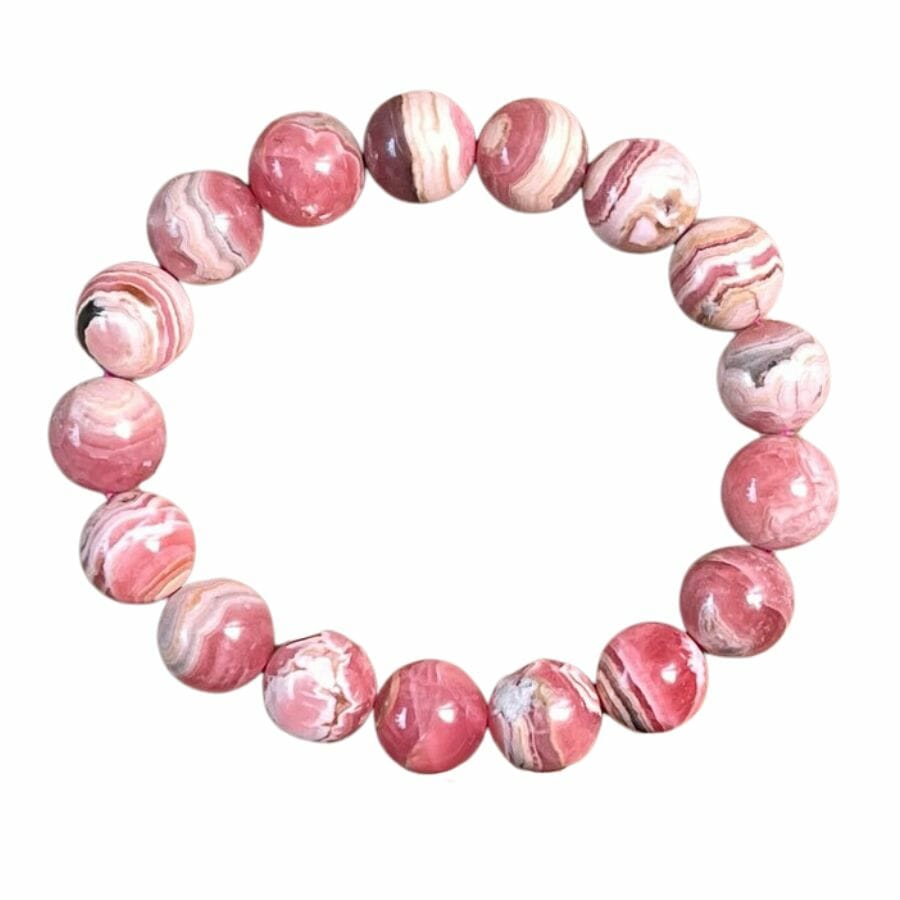
Rhodonite and rhodochrosite share a general similarity in color because they both have a pinkish hue. Because of this, the two minerals can be easy to mistake for each other. But if you look closer, you’ll see subtle differences in their colors.
Take rhodonite. This cool rock can be anything from a sweet, light pink to a super intense red. It’s not shy about showing off its colors.
Now let’s check out rhodochrosite. Sure, it’s also pink, but its style is a little different. There are no deep reds or black streaks here.
Instead, it comes in a range of pink hues. Imagine a soft pastel pink, like cotton candy, all the way to a deeper, rosier shade.
Hardness – Rhodonite is much harder
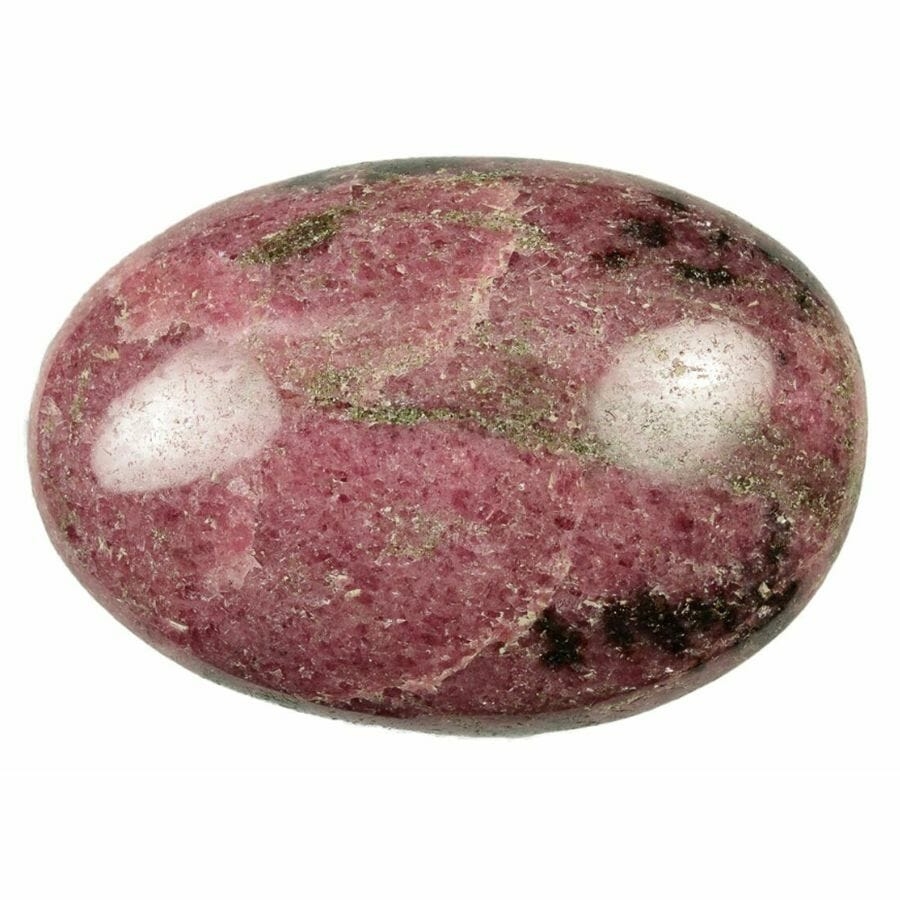
One of the ways we can tell different minerals apart is by examining their hardness. We use a scale from 1 (super soft) to 10 (super hard), called the Mohs scale. That’s how we measure the hardness of minerals.
The hardness of a mineral gives us clues about what it is and how it can be used.
Take rhodonite, for example. It scores between 5.5 and 6.5 on the Mohs scale, which means it’s kinda tough. Pick it up, and you’ll see it can handle a bit of roughing around.
That’s why it’s great for jewelry and decorative stuff. It can handle a few knocks without getting messed up.
On the flip side, we’ve got rhodochrosite. It’s much softer, with a Mohs score of only 3.5 to 4. It’s so soft, even a common nail can scratch it. So, it needs a little more love and care.
But this softness also makes it easier to cut and shape. This is why gem cutters love it, even if it’s a bit delicate.
Crystal structure – Rhodochrosite’s crystals look like slanted cubes
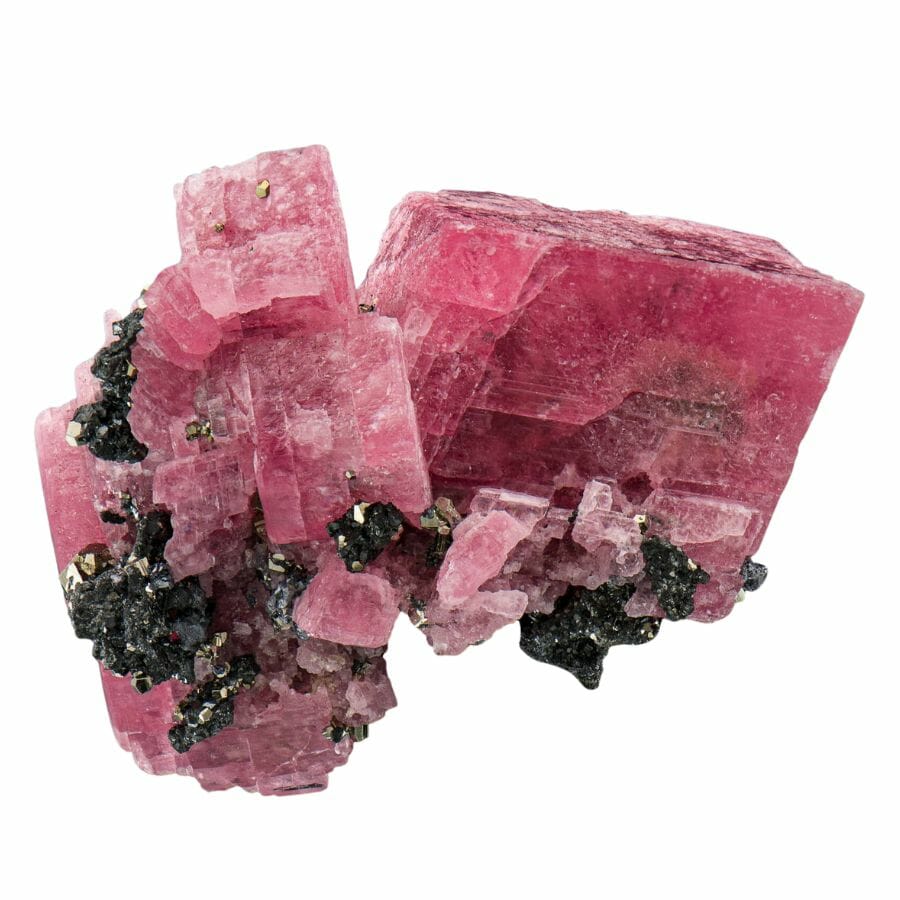
You might think that color or hardness are the only things that make rocks like rhodonite and rhodochrosite different. But there’s more! Their crystal structure, or the way their tiny atoms arrange themselves, also matters.
Take rhodonite. Its atoms form what we call a triclinic system. This sounds like a mouthful but think of it like a box that’s been crumpled up, with sides and angles all over the place.
Because of this, rhodonite usually shows up as compact, grainy clusters, or big chunky pieces.
Now, let’s look at rhodochrosite. Its atoms play a different game. They like to arrange themselves in a trigonal system.
Imagine a can with a top and bottom that look the same, but the sides are a different story. This leads to shapes like hexagons or triangles.
So, rhodochrosite usually forms what we call rhombohedral crystals. They’re kind of like cubes, but slanted.
That’s why rhodochrosite looks so different from rhodonite, even though they might have similar colors. So, you see, the way a mineral’s atoms arrange themselves can make a big difference in how it looks to us!
Cleavage – Rhodonite breaks into two flat surfaces
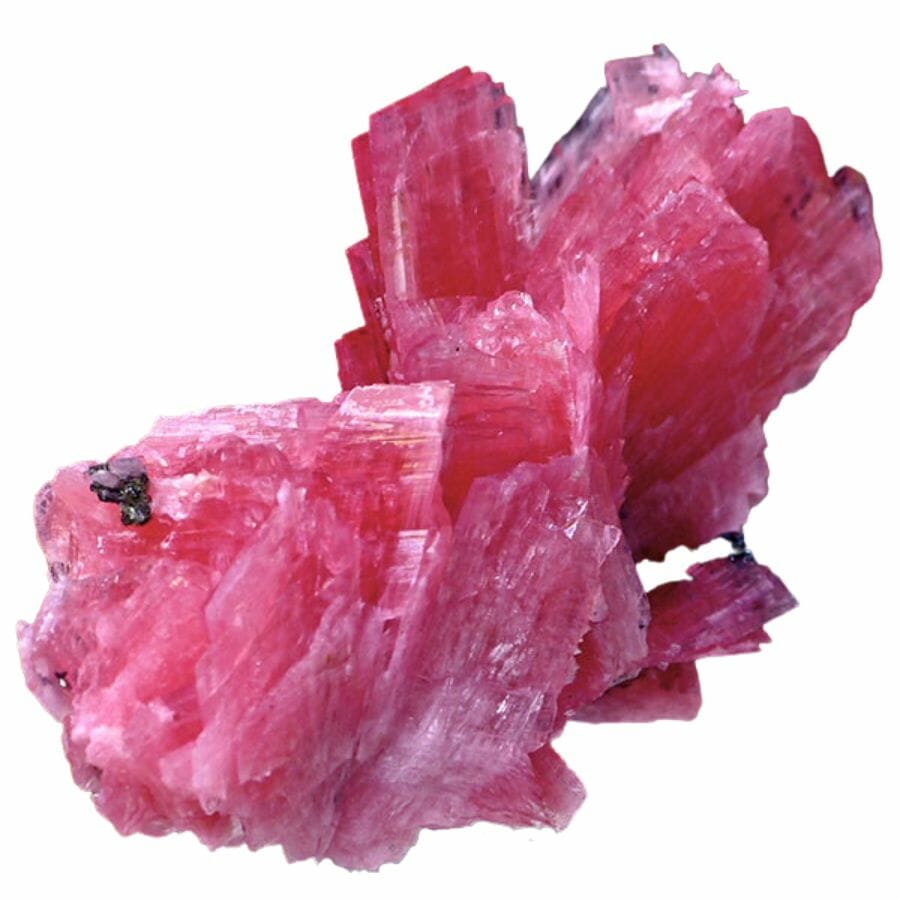
In geology, “cleavage” is a term that describes how minerals break or split when they are hit or put under pressure. This can tell us loads about what’s going on inside the rock.
Take rhodonite, for example. It has what we call perfect cleavage in two directions. This means that if you hit a chunk of rhodonite, it’s going to break in two different ways to create two flat surfaces.
Imagine snapping a chocolate bar along a straight line. That’s the kind of break we’re talking about. The break will be a sharp 90-degree angle, creating edges and corners as sharp as a new haircut.
Rhodochrosite, however, has a different story. It has perfect cleavage in three directions. So, when it gets hit, it breaks into shapes that look like rhombuses.
Chemical composition – Rhodochrosite is a carbonate mineral
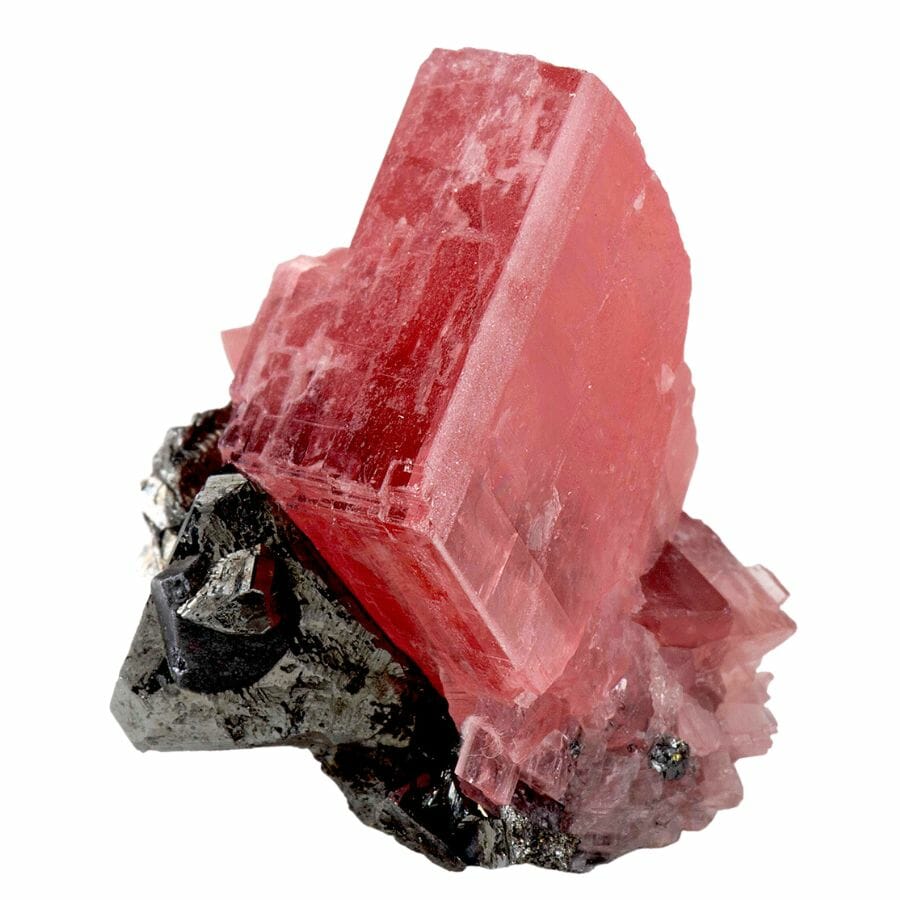
If you want to be able to tell rhodochrosite vs rhodonite, it’s all about knowing these minerals from the inside out. Think of elements as the Lego blocks that make up each mineral. They decide the rock’s color, hardness, and even its structure.
Let’s talk about rhodonite first. It’s made from a cocktail of elements like manganese, iron, magnesium, calcium, silicon, and oxygen. This particular blend gives rhodonite its deep red color and makes it pretty hard.
Silicon and oxygen are like BFFs. They always team up to form a group called silicates. These are super common, they’re found all over the Earth’s crust. Rhodonite is part of this gang.
Now, switch gears to rhodochrosite. It’s a carbonate mineral that’s made of manganese, carbon, and oxygen. This basic trio gives rhodochrosite its pretty pink color and softer touch.
So, while both rhodonite and rhodochrosite have manganese, they’re on different squads. Rhodonite belongs to the silicates, and rhodochrosite belongs to the carbonates.
Formation – Rhodonite is found in metamorphic rocks
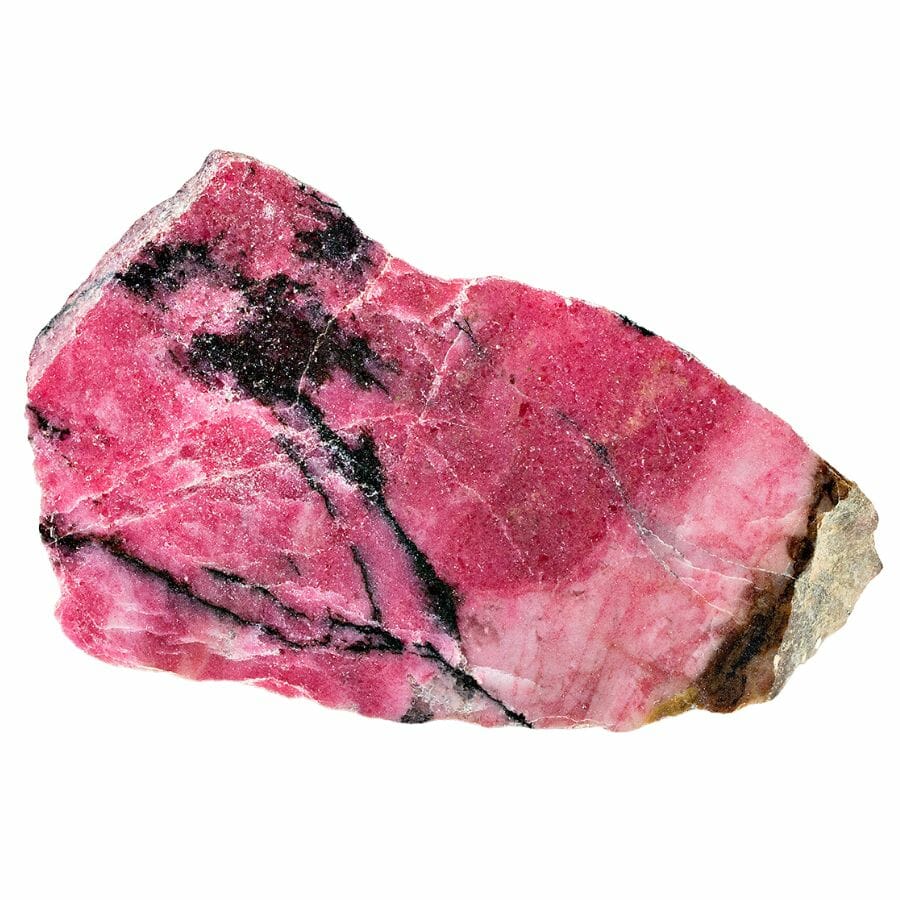
When you look at a mineral, you’re basically holding a piece of Earth’s history. It’s like a tiny time capsule that’s taken millions of years to form deep within the Earth’s crust. Let’s check out how this happens for rhodonite and rhodochrosite.
Rhodonite is born deep in the Earth through changes caused by heat, pressure, and hot watery fluids. This process, called metamorphosis, takes manganese-rich rocks and morphs them into rhodonite.
Just like a caterpillar turning into a butterfly, this transformation takes place in all sorts of conditions. So, every piece of rhodonite has its own unique adventure story.
Rhodochrosite often starts its journey in hydrothermal veins, which are basically Earth’s hot water pipes.
These veins are filled with hot water that’s carrying a bunch of different elements. When the water cools down, these elements stick together to form rhodochrosite.
But that’s not all! Rhodochrosite can also form in sediment layers. These layers are made of tiny pieces of rock, sand, and other bits that harden over time. Just like rhodonite, rhodochrosite can also show up in metamorphic rocks.
So you see, each mineral has its own story to tell about its journey from the depths of the Earth to your hands. If you’re curious about where to find crystals, there are many locations around the world known for their abundant mineral deposits.
Price – Rhodochrosite is more expensive
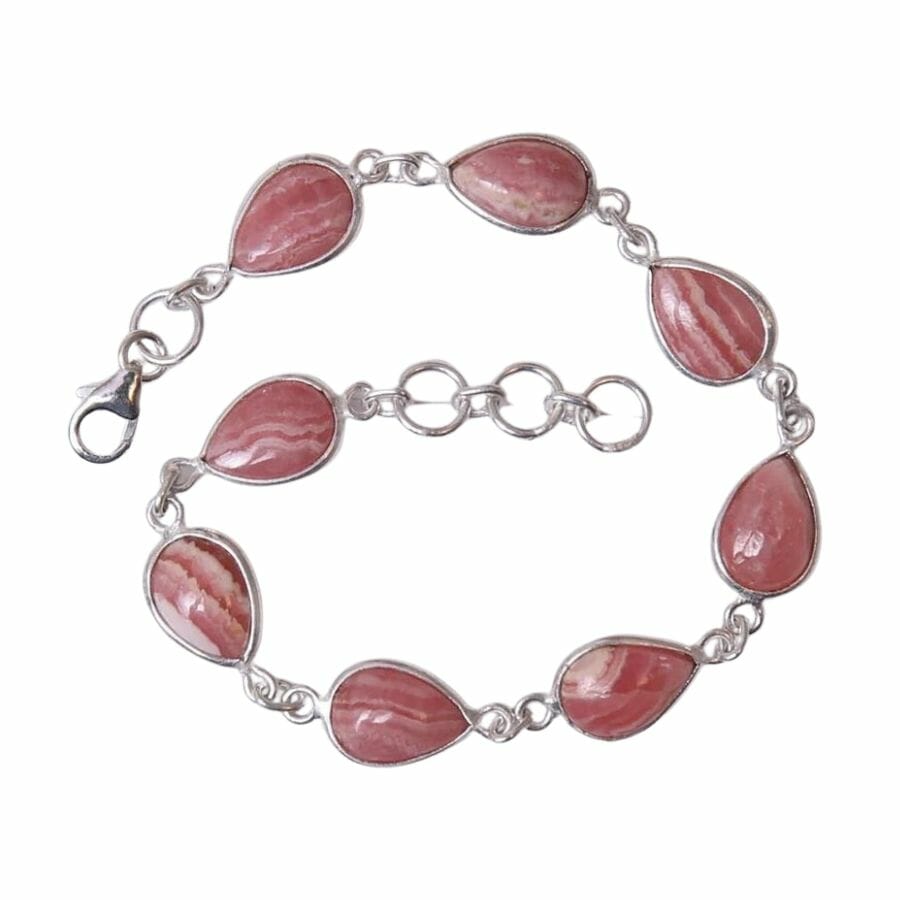
When you start comparing the price tags on rhodonite and rhodochrosite, you’ll notice rhodonite is usually easier on your wallet. But why is that?
Well, it’s all about color, how the minerals form, and what people shopping for gemstones are really looking for.
Rhodonite’s got this cool pink or red color mixed with black lines. There’s no doubt that it’s pretty neat. But it turns out rhodochrosite is usually the crowd favorite.
Rhodochrosite has a special allure, thanks to the neat bands of different shades it often shows. Think about layers of pink and white layered together to make a seriously eye-catching pattern.
This unique look is what makes rhodochrosite more popular and pricier.
But remember, the price of rhodonite and rhodochrosite can jump around depending on a bunch of things. The quality, size, and even where it’s being sold can all play a part.
So, a really high-quality rhodonite can still cost more than a not-so-great piece of rhodochrosite.
Location – Rhodonite is found in Australia and Madagascar
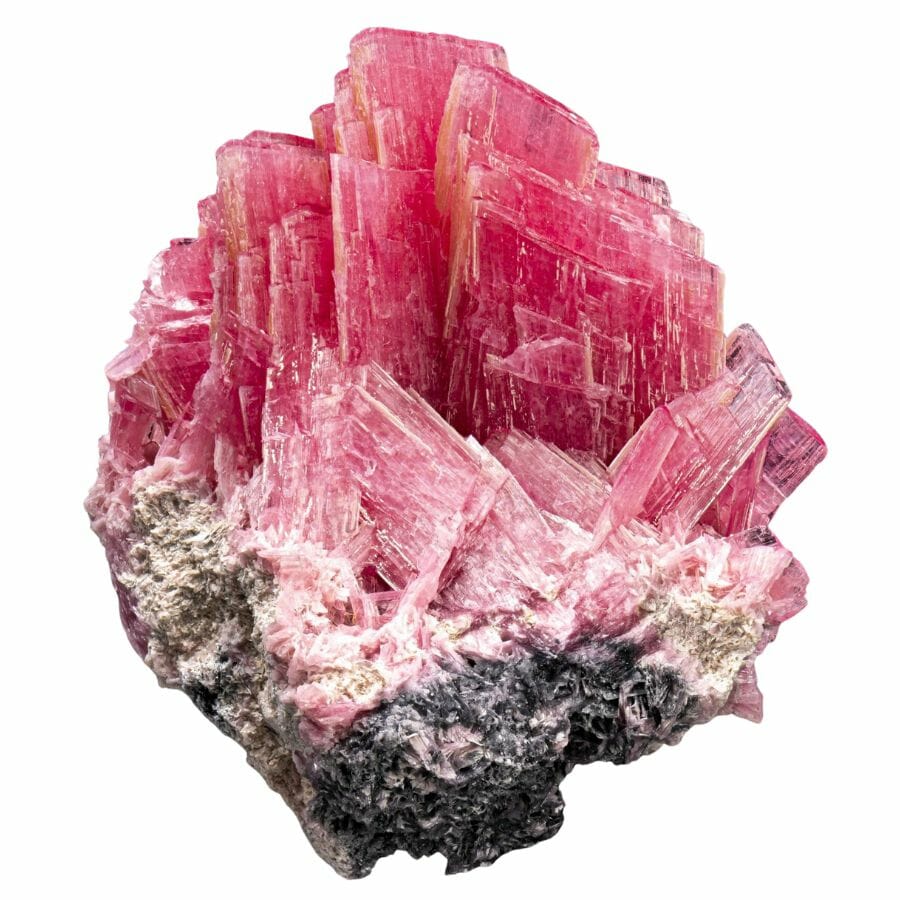
Rhodonite and rhodochrosite are globetrotters! You can find them in various places worldwide, but some spots are just a bit more special.
Rhodonite is found in a bunch of places. Australia is a hotspot for it, and so is Madagascar, an island famous for its unique animals and rocks. You can also find rhodonite up north in Russia and Sweden, and even across the U.S.
Meanwhile, rhodochrosite is often found in Argentina, where some truly gorgeous pieces have been found. South Africa, another treasure trove of minerals, has plenty of rhodochrosite too. You can also find it in Peru.
Interestingly, in the U.S., folks in Colorado love rhodochrosite so much that they made it their state mineral! If you’re an avid rockhound, you might want to add Colorado to your list of the best rockhounding locations in the country.
So, whether you’re chilling in Argentina or Australia down south, or hanging out in Russia or the U.S. up north, you might just stumble upon these beautiful minerals.
But remember, each place can produce rhodonite and rhodochrosite with unique traits, which makes each piece a little reminder of where it came from.
Rhodochrosite vs Rhodonite – The Similarities
Even though rhodonite and rhodochrosite are different in many ways, they also have some cool things in common. Let’s dive into how these two pretty-in-pink gems are more alike than you might think!
Streak – Both minerals leave a white streak
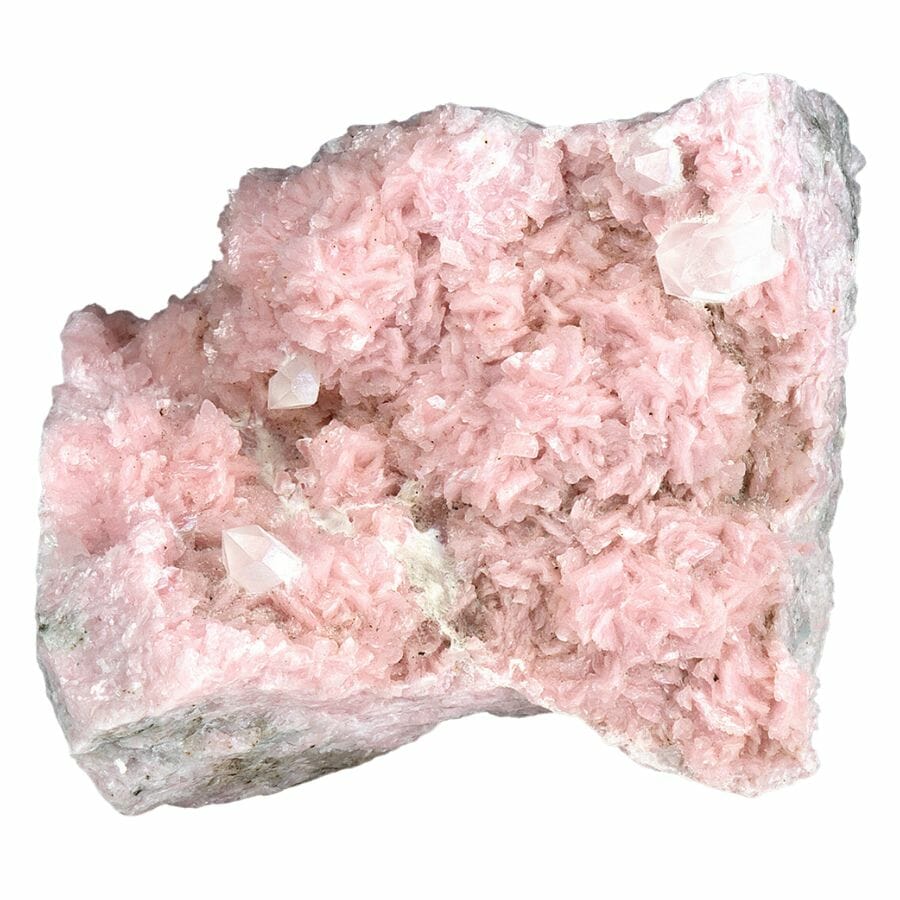
Even though rhodonite and rhodochrosite are made of different stuff, both leave the same color streak.
S streak is the color of the powdery line a mineral leaves behind when you scratch it on a rough surface, like a streak plate.
Picture rhodonite in your mind, with its rich pinks and reds. When you scrape it on a streak plate, it leaves a white line.
Now, let’s talk about rhodochrosite. It’s a looker too, often showing off stripey patterns in different shades of pink and white. But when you try the streak test with it, it also leaves a white line, just like rhodonite.
Luster – They have a shine that looks glassy and pearly
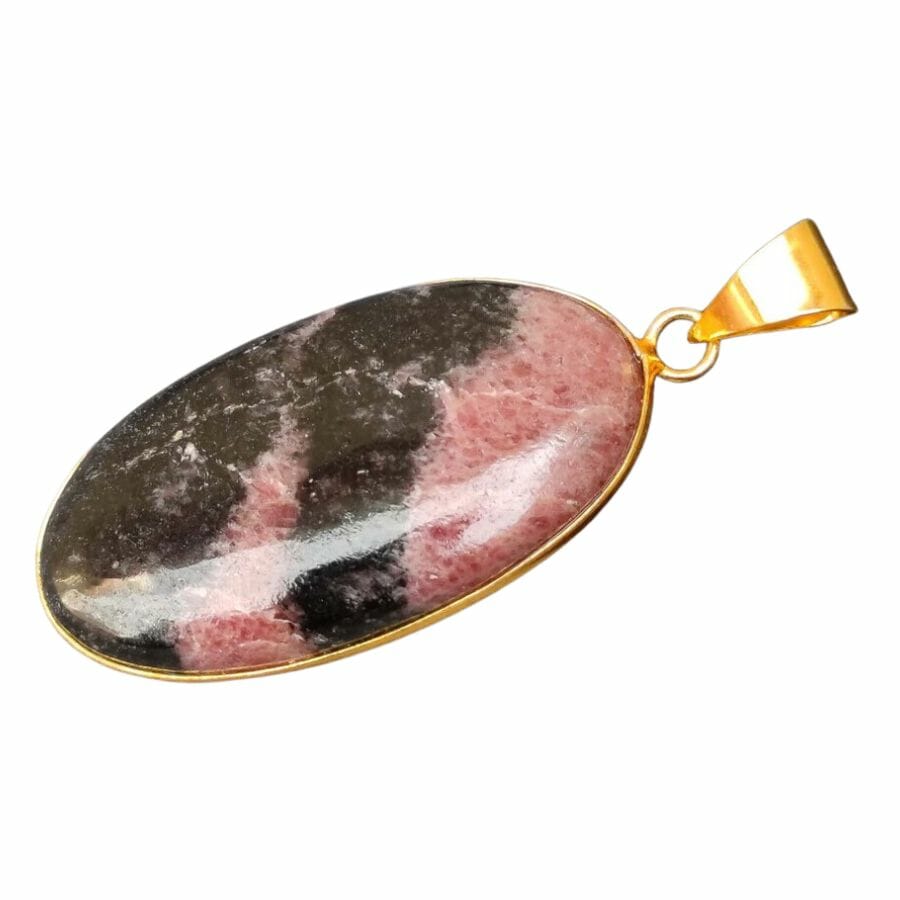
One cool thing about minerals is how they shine or reflect light. This is something we call their “luster.”
Believe it or not, rhodonite and rhodochrosite have a similar kind of sparkle even though they’re quite different in color and how they’re formed.
Rhodonite has what we call a “pearly to vitreous” luster. That’s just a fancy way of saying it has a shiny or glossy look, kind of like the surface of a pearl or a piece of glass. This shine is one of the things that makes rhodonite so eye-catching.
Now, let’s talk about rhodochrosite. It bounces light off in a similar way to rhodonite. It also has that vitreous to pearly luster, which means that it too has that shiny, glossy look.
This sparkle is one of the reasons why both rhodonite and rhodochrosite are so attractive to us.
Density – Both have identical density ranges
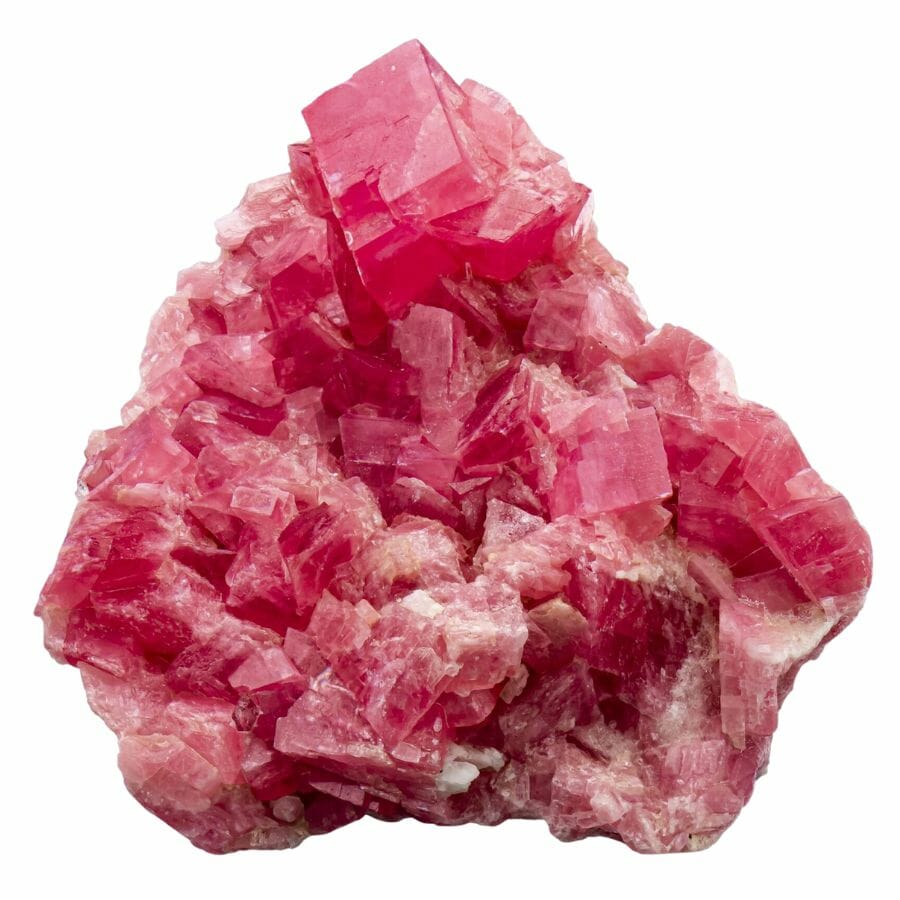
Picture this: you’re holding a piece of rhodonite in one hand and a piece of rhodochrosite in the other. They look different, sure. But you might be shocked to find they feel pretty much the same weight.
That’s because they have the same “specific gravity” – that’s just a fancy term for density.
Rhodonite’s density usually falls somewhere between 3.5 and 3.7.
Even though rhodochrosite looks a bit different, it also has a density that ranges between 3.5 and 3.7. So, despite their differences, rhodochrosite and rhodonite feel about the same weight when you pick them up.
Magnetism – Neither one is magnetic
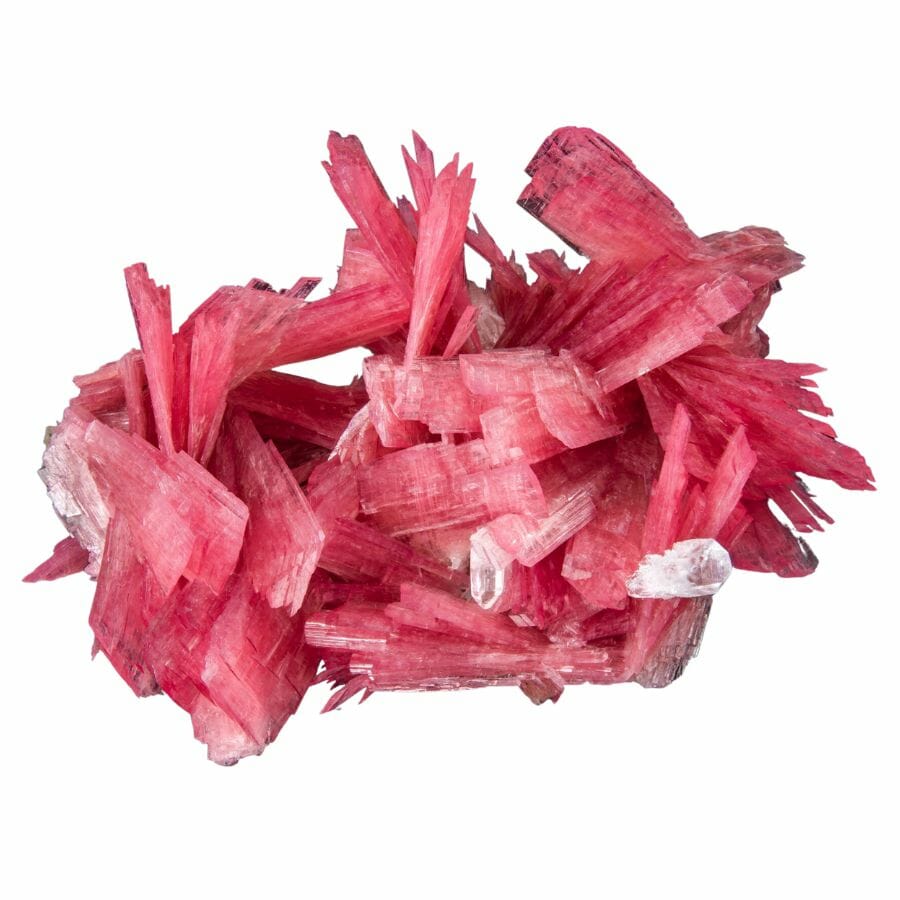
Most minerals aren’t magnetic. Whether a mineral sticks to a magnet or not depends on what it’s made of. Minerals like rhodonite and rhodochrosite just don’t have the right stuff in them to be magnet-friendly.
Even though rhodonite has some manganese in it, it doesn’t have the right mix of elements to be attracted to a magnet. You could wave a magnet over a chunk of rhodonite all day long, and it won’t budge at all.
The same goes for rhodochrosite. It’s not magnetic either. So, if you brought a magnet close to a piece of rhodochrosite, it wouldn’t feel any pull toward it.
Fluorescence – They don’t exhibit fluorescence
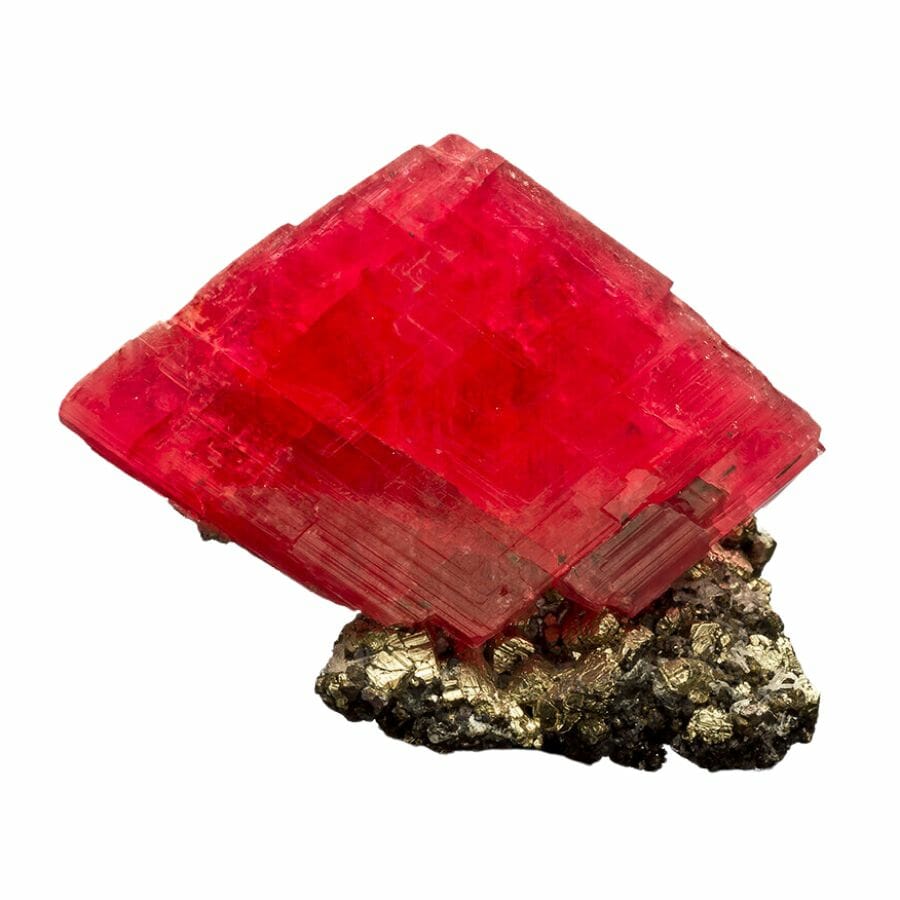
Certain rocks and minerals can glow under a black light. This neat trick is called fluorescence. It happens when some minerals soak up UV light and spit it back out, causing them to light up.
But not all minerals can party under UV light, and that includes both rhodonite and rhodochrosite.
Try shining a black light on rhodonite and you’ll get nothing. No glow at all. That’s because the elements it’s made of – manganese, iron, magnesium, and calcium – just don’t have what it takes to light up when zapped with UV rays.
It’s the same story with rhodochrosite. It won’t light up under a black light either. So, despite looking different, rhodonite and rhodochrosite share this non-glowing quality.
It’s a fun reminder that the rock world is full of cool surprises, and you can’t always tell what a mineral can or can’t do just by looking at it!
Conductivity – Neither mineral works as a conductor
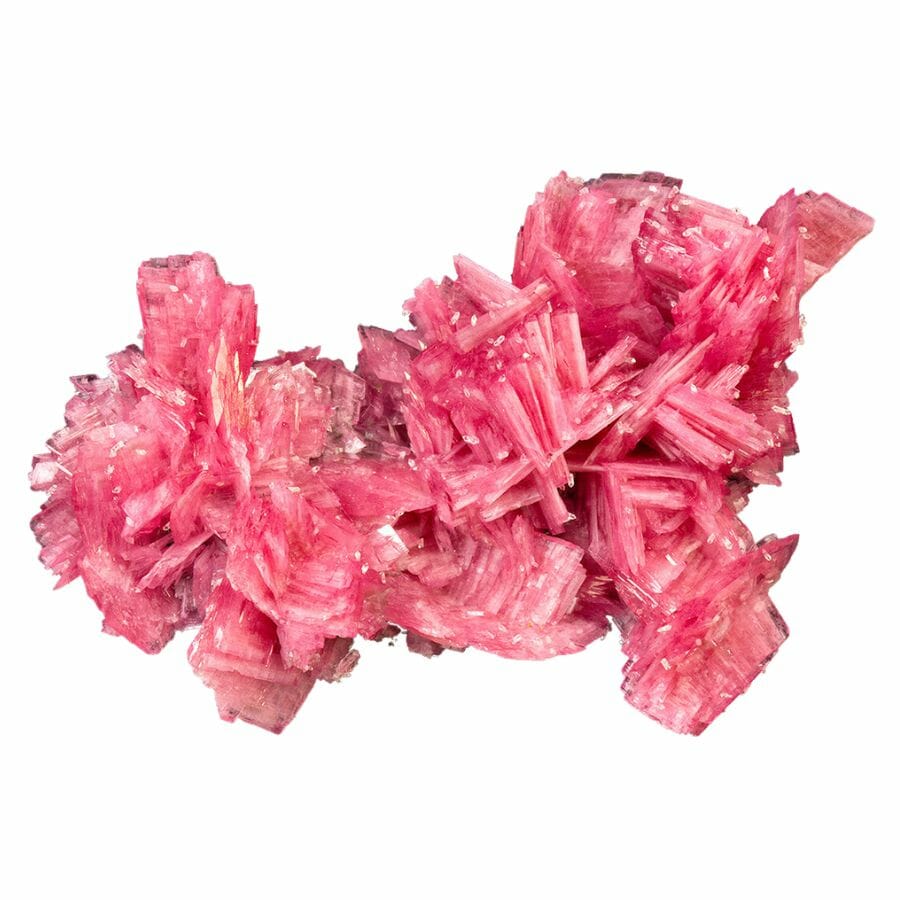
Metals, like the copper in your phone charger, are typically good at carrying electricity. Some minerals can do that too. But that’s not the case for both rhodonite and rhodochrosite.
Rhodonite isn’t great at conducting electricity. It’s a non-metallic mineral, which means it doesn’t have free-roaming electrons, which are the little particles needed to be a good electricity carrier.
So, if you tried to zap it with an electric current, it wouldn’t really do much.
It’s the same deal with rhodochrosite. It’s also a non-metallic mineral, so it’s not really into carrying electricity either. Rhodochrosite’s atoms are stuck together really tight and it’s missing the free electrons that would let it conduct electricity.
The Easiest Ways to Tell Rhodonite and Rhodochrosite Apart
At first look, you might think these two minerals are pretty much the same. I mean, they’re both often pink or red and can be seriously pretty.
But, even though they look kind of similar, there are a bunch of things that can help you spot the difference between rhodonite and rhodochrosite.
Look at the veining or banding on the stone
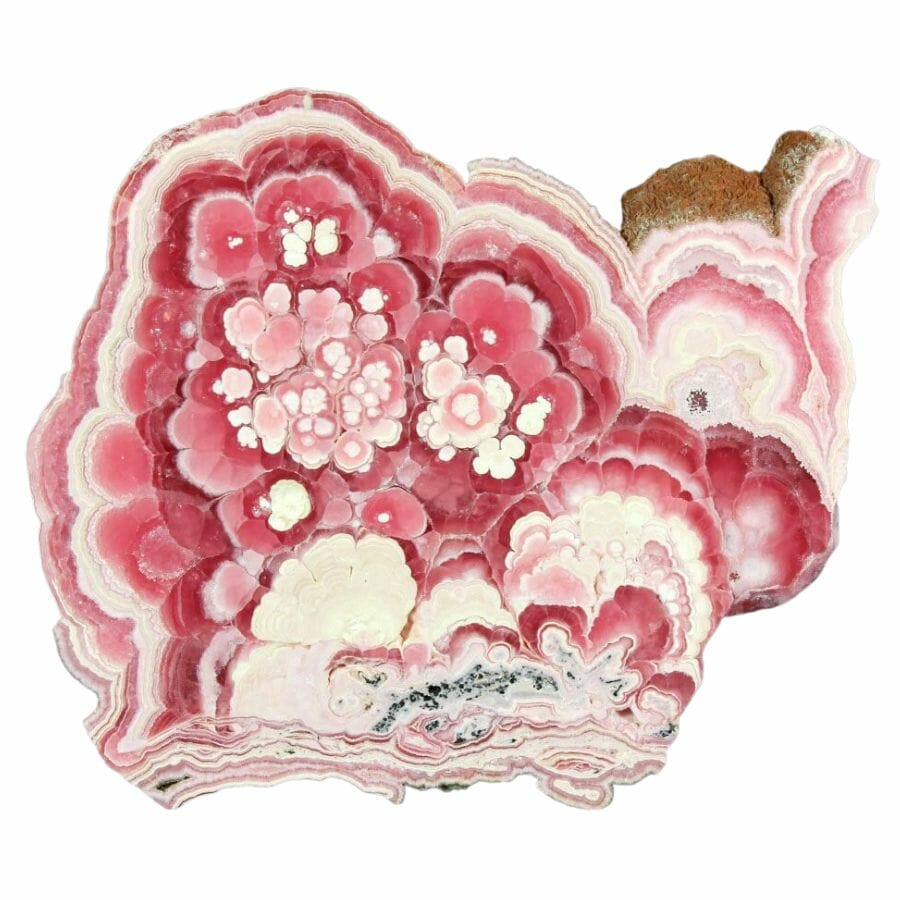
One of the more obvious differences between these two gems is their patterns!
Between the two, rhodonite is kind of the bad boy. Its pink color is usually split up with cool black veins that run all through it.
Think of a pretty pink sunset with dark, stormy clouds cutting across it. Those dark streaks give rhodonite its unique look and help us spot it from other pink gems.
On the other hand, rhodochrosite is more of the quiet, elegant type. Instead of flashy dark veins, rhodochrosite usually has layers that look like cake layers.
So, next time you find a pinkish rock, take a good look at the patterns. If you see dark veins, you likely have rhodonite. If you see gentle pink layers, You’ve likely found some rhodochrosite.
Check the hardness of the stone
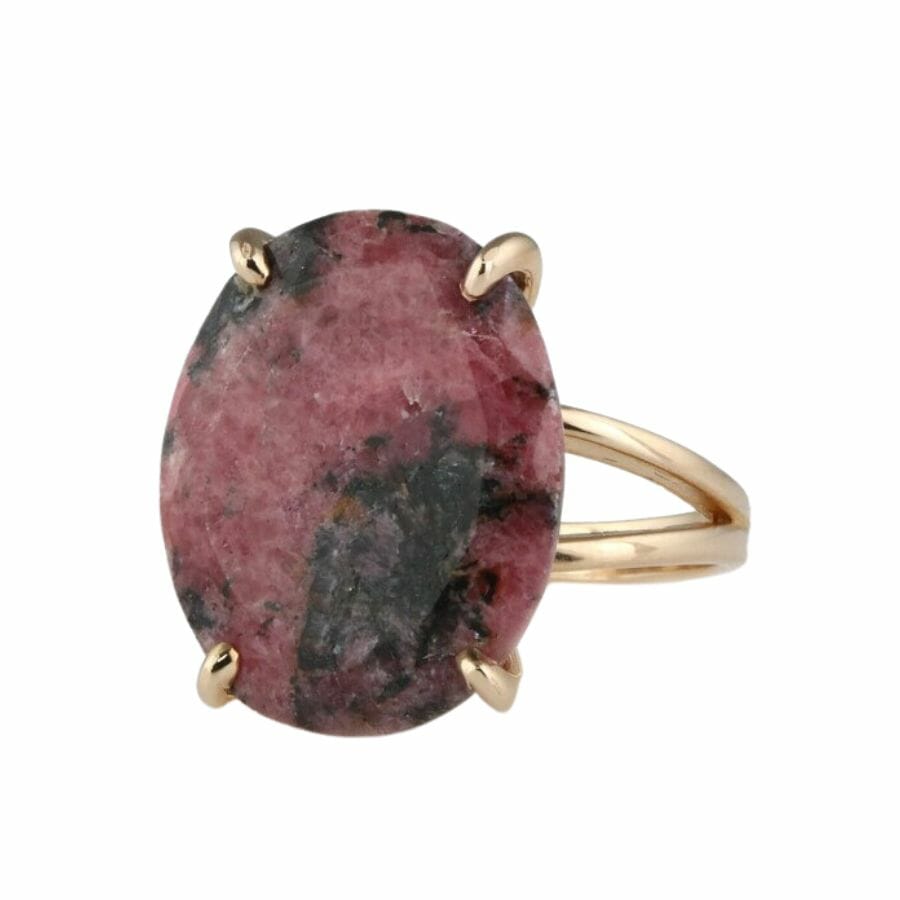
You can use everyday objects to test the hardness of rhodonite vs rhodochrosite. Grab your pocket knife or a shard of glass, and you can do a quick hardness test.
Try to scratch your rock with your knife or glass shard. If you see a scratch appear, you’re probably dealing with rhodochrosite. Why? Because rhodochrosite is softer than glass or a knife.
If your knife or glass can’t scratch the rock, you’ve likely got yourself a piece of rhodonite!
Rhodonite is tougher than a pocket knife or a glass shard. It’s sturdy enough to resist scratching from everyday objects like knives or glass shards.
Use a streak plate
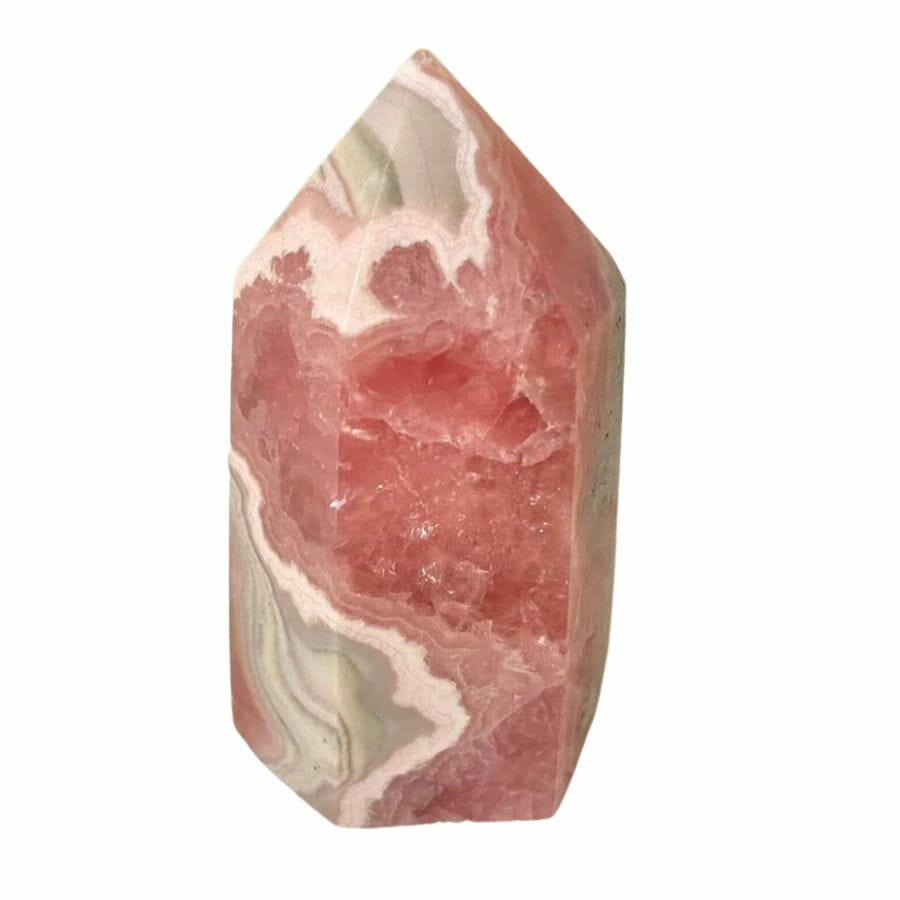
Here’s another neat trick to tell rhodonite and rhodochrosite apart: the streak test! All you need is a streak plate, which is typically an unglazed piece of porcelain tile.
But rhodonite and rhodochrosite both have a white streak. So how is a streak test supposed to help us tell the two minerals apart?
Take your rock and scratch it across the streak plate. If the rock is softer than the streak plate, it will leave a colored streak behind. But if the rock is as hard as or harder than the streak plate, it won’t leave a colored streak.
So, if you’re testing rhodonite, you probably won’t see much of a streak. This is because rhodonite has a hardness similar to, or slightly softer than, the streak plate.
But rhodochrosite is a different story. This mineral is noticeably softer than the streak plate. So, when you scratch it across the tile, it should leave a noticeable colored streak behind, like drawing on paper with a crayon.

